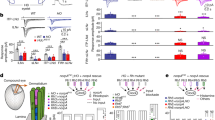Summary
The circadian rhythm in the frequency of spikes recorded from neuron R15 in the isolated abdominal ganglion ofAplysia can be entrained by a lightcycle after the animal's eyes have been removed. Control experiments rule out the possibilities that eyeless entrainment could be due to non-photic time signals impinging on the intact animal or direct action of stimuli impinging on the isolated ganglion.
Similar content being viewed by others
References
Arvanitaki, A., Chalazonitis, N.: Excitatory and inhibitory processes initiated by light and infra-red radiation in single identifiable nerve cell (giant ganglion cells in Aplysia). In: Nervous Inhibition, Florey, E., Ed. New York: Pergamon Press 1961.
Block, G., Lickey, M. E.: Extra ocular photoreceptors and oscillators can control the circadian rhythm of behavioral activity inAplysia. J. comp. Physiol.84, 367–374 (1973).
Eskin, A.: Properties of theAplysia visual system.In vitro entrainment of the circadian rhythm and centrifugal regulation of the eye. Z. vergl. Physiol.74, 353–371 (1971).
Jacklet, J. W.: A circadian rhythm of optic nerve impulses recorded in darkness from the isolated eye ofAplysia. Science164, 562–564 (1969).
Kupfermann, I. J.: A circadian locomotor rhythm inAplysia California. Physiol. Behav.3, 179–182 (1967).
Kupfermann, I. J.: Stimulation of egg-laying by extracts of neuroendocrine cells (bag cells) of abdominal ganglion ofAplysia. J. Neurophysiol.33, 877–881 (1970)
Lickey, M. E.: Seasonal modulation and non-24 hour entrainment of a circadian rhythm in a single neuron. J. comp. physiol. Psychol.68, 9–17 (1969).
Lickey, M. E., Emigh, R. L., Randle, F. R.: A recirculating seawater aquarium system for inland laboratories. Marine Biol.7, 149–152 (1970).
Menaker, M.: Rhythms, reproduction and photoreception. Biol. of Reproduction4, 295–308 (1971).
Strumwasser, F.: The demonstration and manipulation of a circadian rhythm in a single neuron. In: Circadian clocks, Aschoff, J., Ed. Amsterdam: North-Holland Publishing Co. 1965.
Strumwasser, F.: Neurophysiological aspects of rhythms. In: The neurosciences, Quarton, G., Melnechuk, T., Schmitt, F. O. Eds. New York: Rockefeller University Press 1967.
Strumwasser, F., Jacklet, J. W., Alvarez, R. B.: A seasonal rhythm in the neural extract induction of behavioral egg-laying inAplysia. Comp. Biochem. Physiol.29, 197–206 (1969).
Strumwasser, F., Schlechte, F. R., Bower, S.: Distributed circadian oscillators in the nervous system ofAplysia. Fed. Proc.31. 405 Abs (1972).
Author information
Authors and Affiliations
Additional information
Supported by PHS Grant NS 07458 to M.E.L., PHS Predoctoral Fellowship MH 3435 to S.Z. and PHS HSAA RR 06027 to the University of Oregon. We thank Pamela Birrell and Jay Barr for technical assistance, Joan Wozniak for preparing the figure and Monique Prevost for typing the manuscript.
Rights and permissions
About this article
Cite this article
Lickey, M.E., Zack, S. Extraocular photoreceptors can entrain the circadian rhythm in the abdominal ganglion ofAplysia . J. Comp. Physiol. 84, 361–366 (1973). https://doi.org/10.1007/BF00696348
Received:
Issue Date:
DOI: https://doi.org/10.1007/BF00696348



